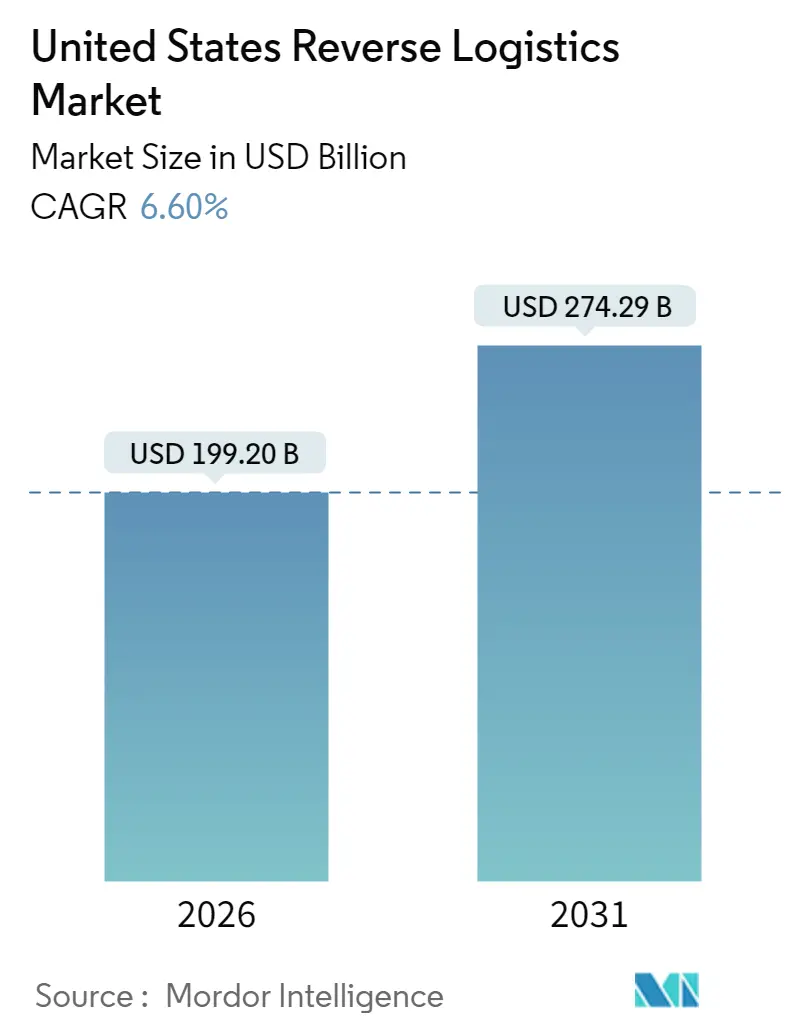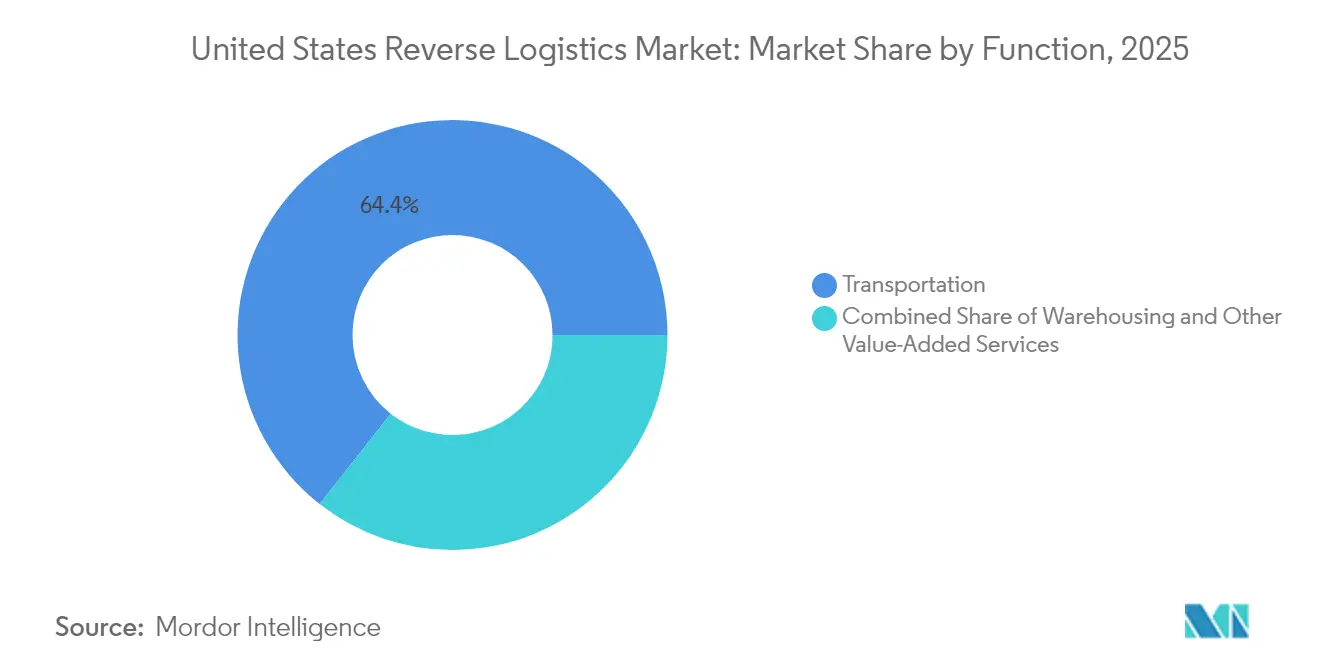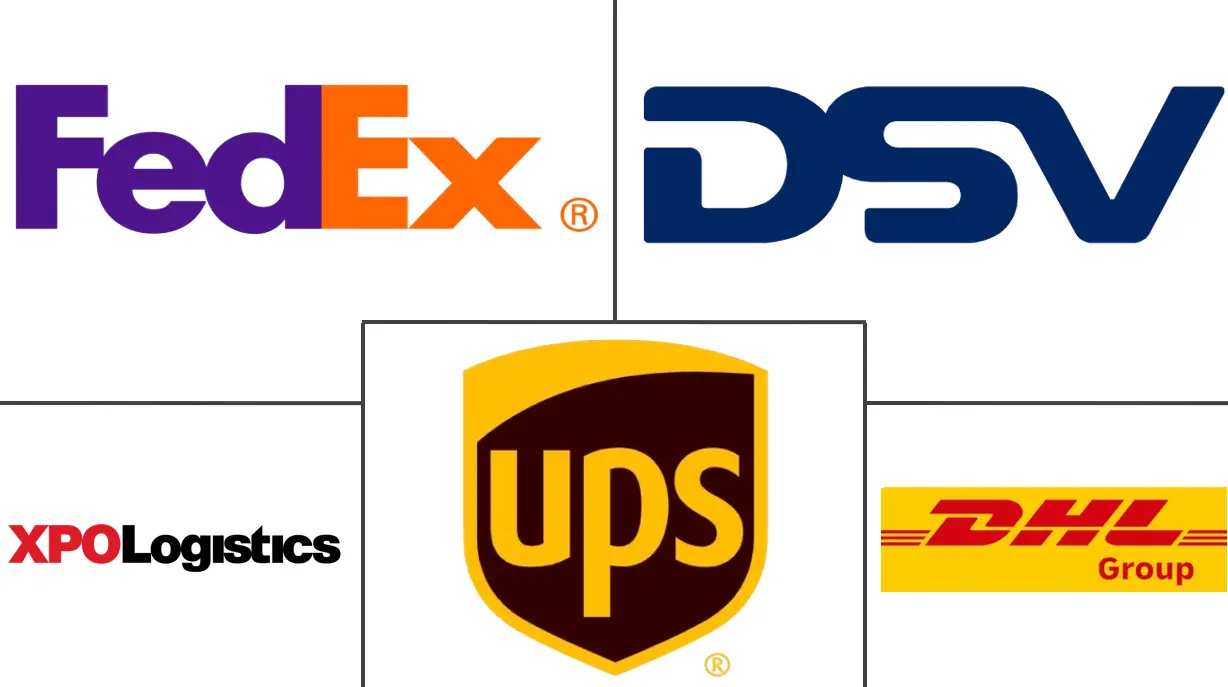United States Reverse Logistics Market Size and Share

United States Reverse Logistics Market Analysis by Mordor Intelligence
United States Reverse Logistics market size in 2026 is estimated at USD 199.2 billion, growing from 2025 value of USD 186.87 billion with 2031 projections showing USD 274.29 billion, growing at 6.6% CAGR over 2026-2031.
Robust e-commerce growth, heightened regulatory scrutiny of electronic waste, and brand strategies that use friction-free returns to win customer loyalty are the chief forces behind this trajectory. Transportation continues to absorb the bulk of spending because returned items originate from millions of dispersed addresses and require rapid repositioning into central processing hubs. At the same time, technology investments in robotics, computer vision, and AI-enabled disposition engines are lowering unit costs, turning returned products into quickly monetized assets, and improving recovery rates. Consolidation among major logistics providers—underscored by headline acquisitions in 2025—signals that only operators with dedicated reverse networks, cold-chain assets, and compliance expertise can fully monetize the opportunity.
Key Report Takeaways
- By function, Transportation held 64.40% of the United States Reverse Logistics market share in 2025, while Other Value-added Services is forecast to post the segment-leading 4.65% CAGR to 2031.
- By end user, Consumer & Retail commanded 40.30% of the 2025 revenue pool, whereas Healthcare & Pharmaceuticals is advancing at the fastest 5.45% CAGR through 2031.
Note: Market size and forecast figures in this report are generated using Mordor Intelligence’s proprietary estimation framework, updated with the latest available data and insights as of January 2026.
United States Reverse Logistics Market Trends and Insights
Drivers Impact Analysis
| Driver | (~) % Impact on CAGR Forecast | Geographic Relevance | Impact Timeline |
|---|---|---|---|
| E-commerce boom lifting return volumes | +1.8% | National, concentrated in major metropolitan areas | Short term (≤ 2 years) |
| Liberal returns policies as competitive differentiator | +1.2% | National, with higher impact in competitive retail markets | Medium term (2-4 years) |
| Sustainability & e-waste regulations | +1.0% | National, with stricter enforcement in California and Northeast | Long term (≥ 4 years) |
| Automation & robotics in returns centers | +0.9% | National, early adoption in high-volume facilities | Medium term (2-4 years) |
| AI-driven predictive return-prevention analytics | +0.7% | National, concentrated in major e-commerce hubs | Medium term (2-4 years) |
| Monetization of recommerce marketplaces | +0.5% | National, with higher penetration in urban markets | Long term (≥ 4 years) |
| Source: Mordor Intelligence | |||
E-commerce Boom Lifting Return Volumes
Online spending growth translates almost directly into higher returns. Retailers frequently encounter “bracketing,” where shoppers order multiple variants with the expectation of sending most of them back, turning reverse flow speed into a pre-purchase selling point. Major parcel carriers now embed returns pick-ups in last-mile route plans to minimize empty-truck miles, an adjustment that cuts dwell time and limits congestion at inbound docks. Returns centers equipped with high-throughput conveyors are also scaling to meet the post-holiday influx, preventing stockouts by redeploying inventory within 48 hours. National retailers that excel at this cycle improve customer lifetime value while recovering more working capital.
Liberal Returns Policies as Competitive Differentiator
Generous return windows, once a courtesy, are now pivotal to conversion. Direct-to-consumer brands that originated the “try-before-you-buy” model require partners that can process and refund within hours, not days, to maintain customer satisfaction scores. Reverse networks, therefore, mirror forward networks in geographic reach and technology stack, linking parcel lockers, in-store counters, and mail-back channels to the same inventory cloud. AI-driven fraud analytics flag unusually high-return personas, allowing retailers to sustain lenient policies without escalating shrinkage. Providers that master this balance earn sticky multi-year contracts from apparel and electronics merchants.
Sustainability & E-waste Regulations
The EPA’s January 2025 rules mandating prior informed consent for cross-border e-waste have redirected large volumes to domestic processors[1]U.S. Environmental Protection Agency, “New International Requirements for Electrical and Electronic Waste,” EPA.gov. Coupled with 25 state-level extended producer responsibility statutes, these rules compel electronics manufacturers to fund collection, refurbishment, or certified recycling. Operators investing in ISO-compliant dismantling lines and secure data-wipe capabilities are capturing high-margin contracts from device makers eager to maintain brand reputation. Cisco’s circular-transformation initiative illustrates how OEM-sponsored take-back programs convert disposal obligations into remanufactured revenue streams.
Automation & Robotics in Returns Centers
Autonomous mobile robots (AMRs) and computer-vision stations now perform triage previously handled by manual sorters, trimming labor hours per unit by up to 40%. Vision algorithms verify SKU, detect cosmetic defects, and print the correct disposition label in real time, moving salvageable items directly to recommerce shelves. Early adopters report safety-stock reductions and faster resale cycles, freeing warehouse capacity for peak events. Capital outlays are recouped quickly because AMRs can be redeployed across peak seasons, maximizing asset utilization.
Restraints Impact Analysis
| Restraint | (~) % Impact on CAGR Forecast | Geographic Relevance | Impact Timeline |
|---|---|---|---|
| High transportation & handling costs | -1.5% | National, with higher impact in rural and low-density areas | Short term (≤ 2 years) |
| Omnichannel returns complexity | -0.8% | National, concentrated in multi-channel retail operations | Medium term (2-4 years) |
| Rising returns fraud | -0.6% | National, with higher concentration in urban markets | Short term (≤ 2 years) |
| Refurbish/recycle capacity bottlenecks for bulky goods | -0.4% | Regional, concentrated in major metropolitan areas | Long term (≥ 4 years) |
| Source: Mordor Intelligence | |||
High Transportation & Handling Costs
Reverse lanes are inherently imbalanced, with trucks often returning partially filled, which elevates cost per unit. Fuel price volatility amplifies the challenge; fleet operators must align with emerging Phase 3 greenhouse-gas standards that require expensive equipment upgrades[2]Environmental Protection Agency, “Greenhouse Gas Emissions Standards for Heavy-Duty Vehicles – Phase 3,” FederalRegister.gov. To protect margins, providers consolidate parcels into regional cross-docks and negotiate dynamic backhaul agreements to boost load factors. Yet for low-value merchandise, transportation alone can erase resale profit, pushing volume toward liquidation instead of refurbishment.
Omnichannel Returns Complexity
Consumers expect any-channel returns, yet each path—store counter, parcel carrier, locker, or scheduled pickup—creates discrete data, labeling, and reconciliation steps. Retailers must maintain SKU lineage to ensure the correct refund method, restock location, and tax treatment. Integrating point-of-sale systems with warehouse management software remains a costly undertaking. Brands lacking this transparency face inventory inaccuracies that cascade through replenishment planning. Third-party specialists offering “returns management as a service” are absorbing smaller players that cannot marshal the required IT investment.
Segment Analysis
By Function: Transportation Dominates Infrastructure Investment
Transportation generated 64.40% of the United States Reverse Logistics market size in 2025, underscoring the primacy of collection and repositioning in value recovery. Parcel and less-than-truckload carriers have deployed dedicated returns lanes that sync with outbound routes, maximizing network density. Airfreight continues to handle high-value or temperature-sensitive returns, notably from the medical-device trade. Warehousing follows as the secondary cost center; multi-client campuses near major ports and interstates shorten cycle times for cross-docked items. Other Value-added Services (repair, refurbishment, grading, and certified destruction) capture rising demand as brands pursue circular models, propelling this sub-segment’s 4.65% CAGR to 2031. Providers bundling transportation with these services command premium yields because they control the full disposition chain.
Second-generation facilities now combine robotic sortation, data-sanitized test labs, and e-commerce photo booths to list recovered items on recommerce marketplaces the same day they arrive. This shift embeds incremental revenue inside the United States Reverse Logistics market rather than outsourcing it to liquidation wholesalers. Long-haul carriers are likewise adding dockside triage to reduce wasted miles, proving that functional integration yields both margin and sustainability wins.

Note: Segment shares of all individual segments available upon report purchase
By End User: Healthcare Drives Specialized Growth
Healthcare & Pharmaceuticals, though still a smaller slice in absolute dollars, is projected to expand at a 5.45% CAGR (2026-2031), outpacing every other vertical. Temperature-controlled packaging, DEA chain-of-custody rules, and FDA administrative-destruction thresholds under USD 2,500 make this sector uniquely complex. Carriers must supply validated cold-chain assets and batch-level serialization to prevent diversion or spoilage. UPS’s USD 1.6 billion acquisition of Andlauer in April 2025 materially strengthens its share of the United States reverse logistics market in this niche.
Consumer & Retail retains the largest revenue block at 40.30% in 2025, but faces margin compression from free-returns expectations. Apparel, footwear, and consumer electronics dominate volumes, while home-furnishings returns require specialized white-glove collection that many parcel carriers avoid. Fast-fashion brands increasingly contract providers that guarantee two-day relisting, allowing them to preserve trending inventory value. Across sectors, end users reward partners that blend compliance, speed, and recommerce fluency.

Note: Segment shares of all individual segments available upon report purchase
Geography Analysis
Coastal megaplexes anchor the United States Reverse Logistics market because population density and port access concentrate both forward shipments and returns. The Northeast corridor—from Boston through Atlanta—houses a critical mass of robotics-enabled facilities, allowing same-day receipt and restock for items purchased in the nation’s largest consumer markets. California’s stringent electronics-recycling mandates elevate demand for e-waste certified processors, pulling investment into Inland Empire industrial zones where 40-foot containers can transfer to domestic intermodal quickly.
The Midwest offers cost-effective centrality. Chicago, Indianapolis, and Columbus serve as national consolidation nodes where multi-tenant hubs lower average haul distances. These cities attract advanced automation pilots because land costs are lower than coastal counterparts, yet connectivity via rail and Interstate highways remains robust. Southern states, benefiting from population inflows and new e-commerce fulfillment builds, record the fastest regional growth rates even though infrastructure remains comparatively nascent. Providers are layering spoke facilities near Dallas, Houston, and Nashville to capture rising parcel density.
Competitive Landscape
The United States Reverse Logistics market is fragmented, with numerous players operating across the sector. However, DHL Supply Chain’s January 2025 purchase of Inmar bolstered its network by 14 return centers and 800 associates, vaulting it into the market-leadership position[4]DHL, “DHL Acquires Reverse Logistics Leader Inmar Supply Chain Solutions,” Group.dhl.com. UPS counters with specialized depth, integrating Andlauer’s cold-chain assets to dominate healthcare returns. DSV’s April 2025 acquisition of DB Schenker strengthens its cross-border capabilities, signaling intensifying competition among global integrators.
Scale alone is insufficient; technology is the differentiator. Returns hubs outfitted with AMRs process upward of 3,000 units per hour while producing granular SKU-level recovery metrics that feed predictive stocking algorithms. Emerging analytics platforms licensed by large omnichannel retailers propose optimal disposition—restock, refurbish, donate, or recycle—within seconds, lifting recovery margins. Specialist startups focus on bulky-item categories such as furniture, offering pick-up crews and refurbishment workshops that mainstream carriers lack.
Customer stickiness hinges on end-to-end visibility. Enterprises demand API hooks into carrier, warehouse, and finance systems to reconcile refunds automatically. Players unable to provide this transparency face churn as clients seek partners that convert reverse flow from cost center to profit engine. Consolidation is thus expected to continue, with niche innovators acquired for their intellectual property and compliance certifications rather than their fleet size.
United States Reverse Logistics Industry Leaders
United Parcel Service (UPS)
FedEx Corp.
XPO Logistics
DSV
DHL Supply Chain
- *Disclaimer: Major Players sorted in no particular order

Recent Industry Developments
- April 2025: UPS announced its acquisition of Andlauer Healthcare Group for USD 1.6 billion, expanding cold-chain reverse capabilities for pharmaceutical returns.
- April 2025: DSV acquired DB Schenker for EUR 14.3 billion (USD 14.9 billion), creating a combined logistics network with roughly EUR 39.3 billion (USD 41 billion) in pro-forma revenue.
- January 2025: DHL Supply Chain completed its acquisition of Inmar Supply Chain Solutions, adding 14 reverse-processing centers and 800 employees to its North American.
- August 2024: FedEx partnered with Blue Yonder's Doddle unit to expand return drop-off locations by nearly 2,000 sites across the United States.
United States Reverse Logistics Market Report Scope
A complete background analysis of the US reverse logistics market, including an assessment of the economy and contribution of the logistics sector in the economy, along with market overview and market size estimation for the key segments, and emerging trends in the market segments. The report also covers an analysis on the market dynamics and key insights of the market.
| Transportation | Road |
| Air | |
| Other Modes | |
| Warehousing (Storage, Distribution, Consolidation) | |
| Other Value-added Services (Return Processing, Restocking, Refurbishment, Disposition) |
| Consumer & Retail |
| Home & Decor |
| Healthcare & Pharmaceuticals |
| FMCG |
| Other End Users |
| By Function | Transportation | Road |
| Air | ||
| Other Modes | ||
| Warehousing (Storage, Distribution, Consolidation) | ||
| Other Value-added Services (Return Processing, Restocking, Refurbishment, Disposition) | ||
| By End User | Consumer & Retail | |
| Home & Decor | ||
| Healthcare & Pharmaceuticals | ||
| FMCG | ||
| Other End Users |
Key Questions Answered in the Report
How large is the United States Reverse Logistics market in 2026?
It stands at USD 199.2 billion, with a forecast to reach USD 274.29 billion by 2031.
What is the projected CAGR for reverse logistics services in the United States?
The market is expected to grow at a 6.60% CAGR between 2026 and 2031.
Which functional segment contributes the most revenue?
Transportation dominates, accounting for 64.40% of 2025 spending.
Which end-user vertical is growing the fastest?
Healthcare & Pharmaceuticals is advancing at a 5.45% CAGR through 2031.
How are e-waste regulations influencing service demand?
EPA rules effective January 2025 require domestic processing, driving investment in certified recycling and refurbishment capacity.
What recent acquisitions signal consolidation in U.S. reverse logistics?
Key deals include UPS-Andlauer (USD 1.6 billion), DHL-Inmar, and DSV-DB Schenker, each expanding specialized infrastructure and scale.



